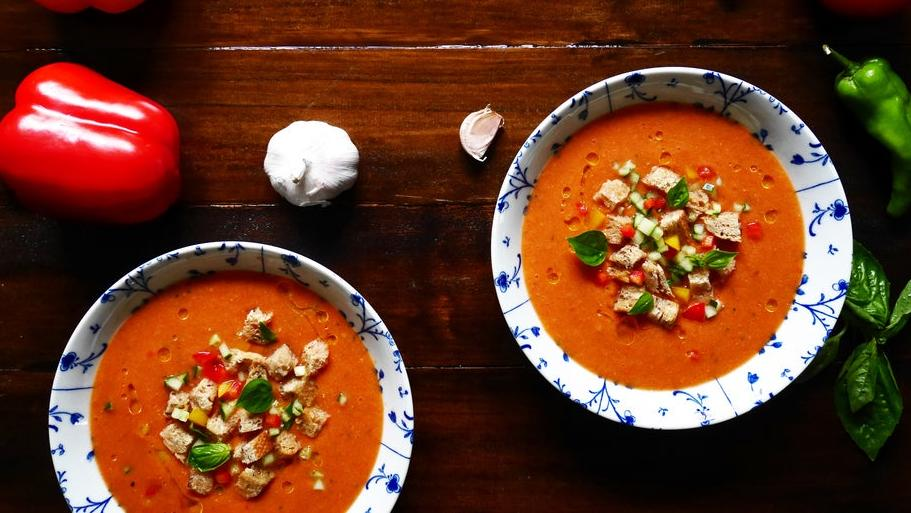What We're Not Going To Do Is Call Gazpacho Cold Tomato Soup
The rich history behind Andalusia’s signature dish.
The leafy orange trees that line cobblestone streets are the first image of Spain's Andalusia region that comes to mind for many travelers, but for me, it's the zesty bites of gazpacho that sealed my first impression. The landscape of this autonomous area of Southern Spain is truly stunning: Medieval architecture accented with the graceful arches and tilework of the Moors rising in the shadow of mountains and along a pebbled coastline. Andalusia's scenery dazzles the senses to the point that it's difficult to come away with the words to sum it up. Gazpacho, however, comes close to capturing it all, with fresh flavors that illustrate Andalusia's history and cultural influences. And no, to all the haters out there, it's not just cold tomato soup.
I fell in love with the sunny climate and multifaceted culture of Andalusia from the moment I landed. Visiting the mountain villages of the Alpujarras, the beaches and fortress of Almeria, and especially the ancient landmarks of Granada left an indelible mark on my traveler's soul.
I was fascinated by the mix of North African Moorish culture with Spanish history, a combination that defines the region. Evidence of this cultural melange is everywhere, from the central courtyards and tiled fountains that dot the homes to the teahouses, or teterias, that dominate the area while the rest of the country is steeped in coffee culture. Most of all, it's the ingredients and preparation of the local cuisine that really reflect this.
How Andalusia’s history influences its cuisine
Sinking my teeth into berenjenas fritas con miel (fried eggplants with honey) was my introduction to the Moorish love for the sweet and savory. This tapa is popular throughout Andalusia, and I enjoyed the crispy texture paired with the moistness of the honey.
The Moors brought eggplants to Spain—as well as oranges, lemons, apricots, pomegranates, rice, and sugar—hundreds of years ago. They also established the practice of frying fish in olive oil. One of my most memorable experiences on the beach in Almeria was munching espetos de sardinas (fried sardines on a skewer) sold at chiringuitos, or beachside cafes.
Another favorite Moorish-influenced treat is marzipan candy and polvorones, a powdery almond shortbread. The Moors pioneered using ground almonds for pastries, and it shows up in practically all the desserts in Andalusia and the rest of Spain, including turron Christmas sweets and tarta de almendras, or almond cake.
What is gazpacho?
All of these dishes were great, but they did not match the sensory glory of gazpacho. My first taste of Andalusian gazpacho was in a Granada sidewalk cafe. The sun was pouring down on the plaza and the spicy flavors of fresh tomatoes, peppers, olive oil, and garlic lingered on my tongue and instantly refreshed me. It was like sipping summer in a bowl.
As I traveled through the region, I discovered that each town had its own variation on gazpacho. In Cordoba, it's called salmorejo and calls for day-old bread, tomatoes, garlic, and olive oil to form a thick soup topped with ham and chopped hard-boiled eggs; salmorejo is overall heartier than gazpacho. In Málaga, there's ajo blanco, which uses ground almonds, garlic, olive oil, vinegar, and bread to make a chilled, elegant soup topped with grapes that I loved almost as much as gazpacho.
Granada's version of gazpacho is considered the original, dating back to the middle ages when the Moors brought almonds and bread, and olive oil and vinegar were daily staples. Tomatoes and peppers didn't arrive until Christopher Columbus brought them back from the new world.
Gazpacho serves up Andalusian history and culture in every savory bite, but that's not all it does. The simple yet balanced mix of ingredients proves beyond a doubt that it's not just cold tomato soup.
Homemade Gazpacho
Gazpacho recipe courtesy of the Tourism Office of Spain
Serves 4
- 1 kg ripe tomatoes
- 2 small green peppers, diced
- 2 garlic cloves, minced
- 100 g farmhouse bread
- 4 Tbsp. extra virgin olive oil
- 1 Tbsp. sherry vinegar
- 1 egg
- Bread
- Salt
Soak the bread in boiling water and then crush with the diced vegetables, olive oil, sherry vinegar, salt, and water, according to how thick you want the soup to be. (Nowadays we use a mixer, which has the advantage of producing a finer blend of vegetables.)
Serve in four individual clay dishes. The presentation is usually accompanied by tomato, cucumber, green pepper, onion, bread, and hard-boiled egg, all finely diced. Everyone can serve themselves according to taste.
